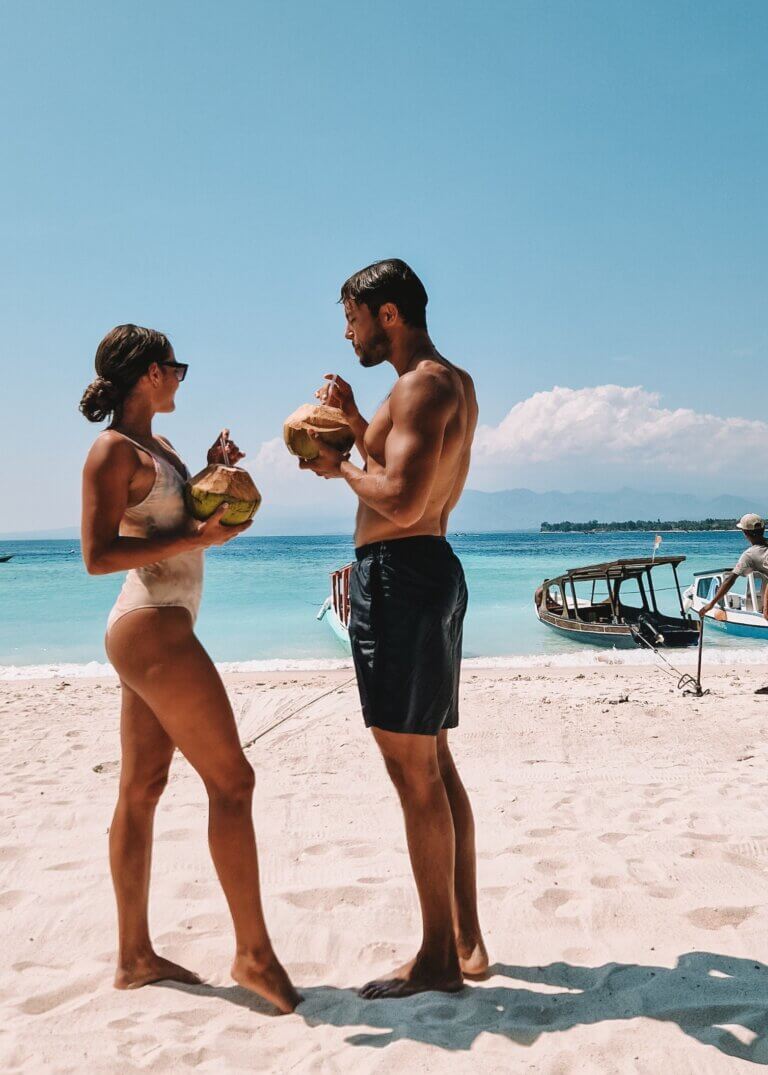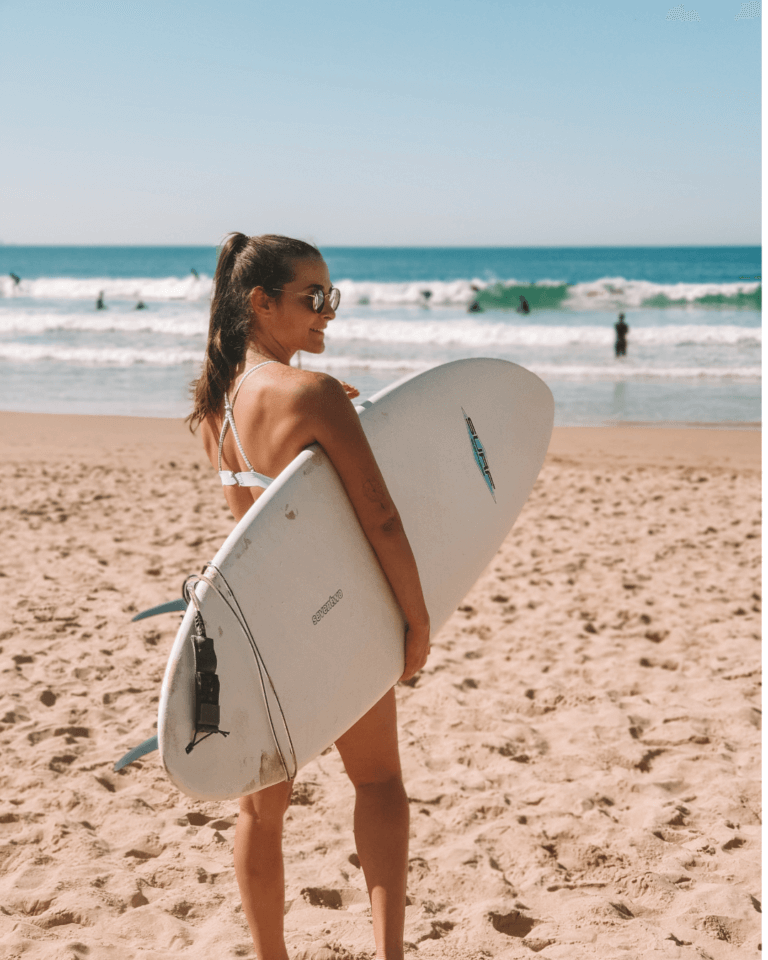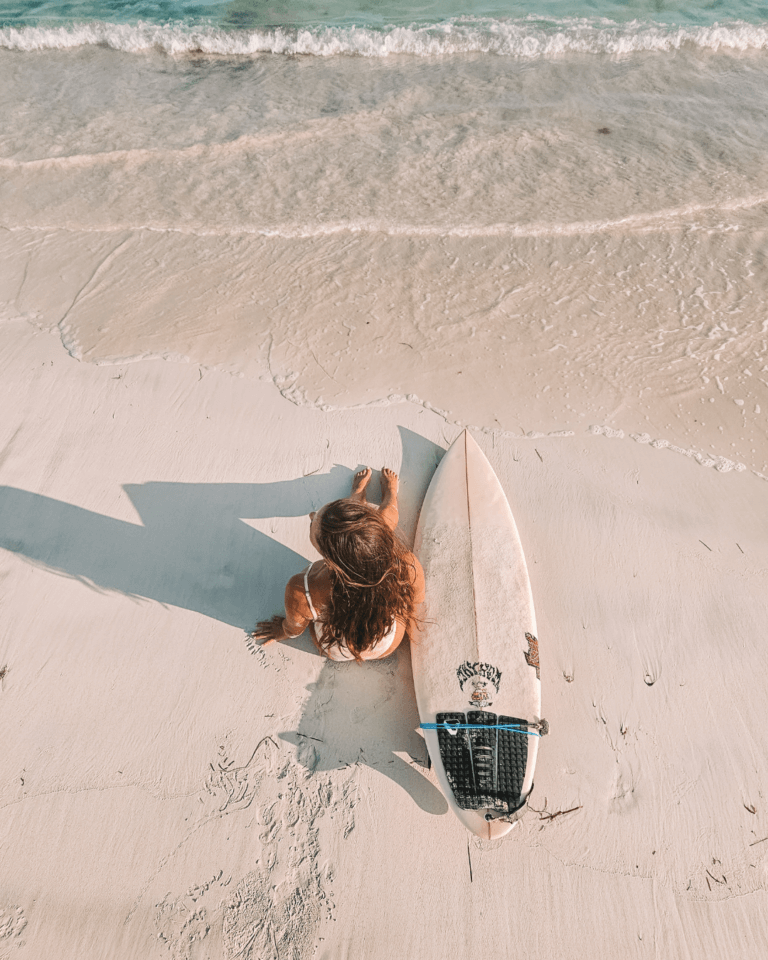The 8 Best Surf Spots in Bali for Beginners & Intermediates
This post is all about Surfing in Bali – the best Surf Spots in Bali for Surf Beginners and Intermediate Surfers.
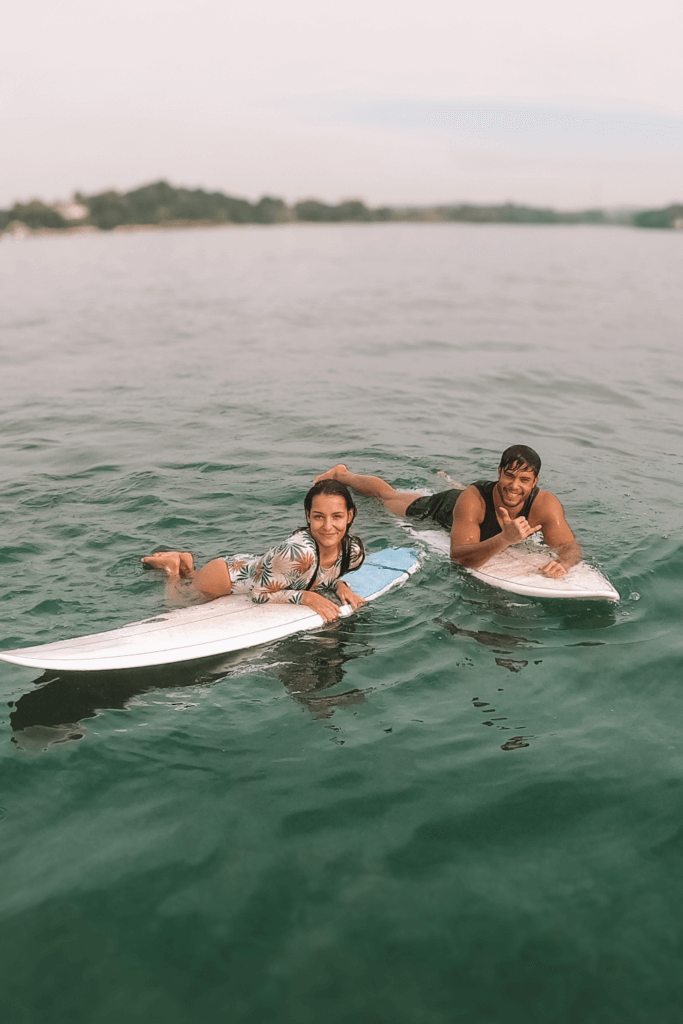
Bali is undoubtedly one of the most popular travel destinations for surfers worldwide. With its tropical temperatures, endless beaches, vibrant culture, and a wide range of restaurants, cafés, and leisure activities, the island truly has it all.
It’s no surprise that Bali is considered a surfer’s paradise: year-round, you’ll find amazing waves for every skill level—whether during the dry season from April to November or the rainy season from November to March.
I myself started surfing in Bali in 2018 and spent six months living on the island in 2023. This personal connection and countless hours in the water have helped me discover the best surf spots in Bali for every level.
Whether you’re just starting out or already have some experience, by the end of this article, you’ll know exactly where to hit the waves!
Affiliate Disclaimer: Some of the links in this post are affiliate links. with no extra costs for you View the disclosure for more information.
The 8 Best Surf Spots in Bali für Beginners & Intermediates
The following selection of the best surf spots in Bali is perfect for your first surfing attempts, as well as for those with a bit more experience. Keep in mind that the suitability of these spots heavily depends on the conditions. As a beginner, it’s generally best to avoid large surf conditions over 1.5 meters. The ocean is much stronger than we are, and without experience, knowledge of currents, and sufficient fitness, it can quickly become dangerous.
If you’re heading out without a surf guide, make sure to check the surf forecast in advance and choose the spot that offers suitable wave conditions.
Related Posts
(Explore the “How To Surf” category for essential surf theory, such as how to read a surf forecast, as well as helpful tips for beginners.)
1. Kuta Beach
Kuta is a popular and lively holiday destination for surfers and beachgoers, day and night. Back in the 90s, Kuta gained fame as Bali’s party hotspot. It’s always busy here, and there’s no shortage of action! While you might not find much Bali flair, you’ll definitely find great waves for surfing. Kuta Beach is considered one of the best surf spots in Bali for beginners.
The over 2 km long sandy beach offers consistent wave conditions that are ideal for beginners and intermediates. The gently sloping beach break makes learning to surf both comfortable and safe.

Potential Hazards:
- Currents: The currents at Kuta Beach can become very strong. Be sure to pick a fixed point on the shore and check regularly to ensure you haven’t drifted too far from your intended practice zone.
- Other surfers: While you’ll find a spot along the long stretch of beach, be mindful of other surfers. Many beginners in one spot increase the risk of out-of-control surfboards, which could hit you.
Surf Report Kuta Beach:
2. Seminyak Beach
Pantai Seminyak, the neighboring beach of Kuta, is another popular spot for surf beginners, particularly the “Gado-Gado” surf spot. I spent many of my first surf lessons here as well. It’s a pleasant beach break offering excellent conditions for your first attempts on a surfboard. No surprise, this spot is especially popular among surf schools. However, this also means it can get quite crowded.
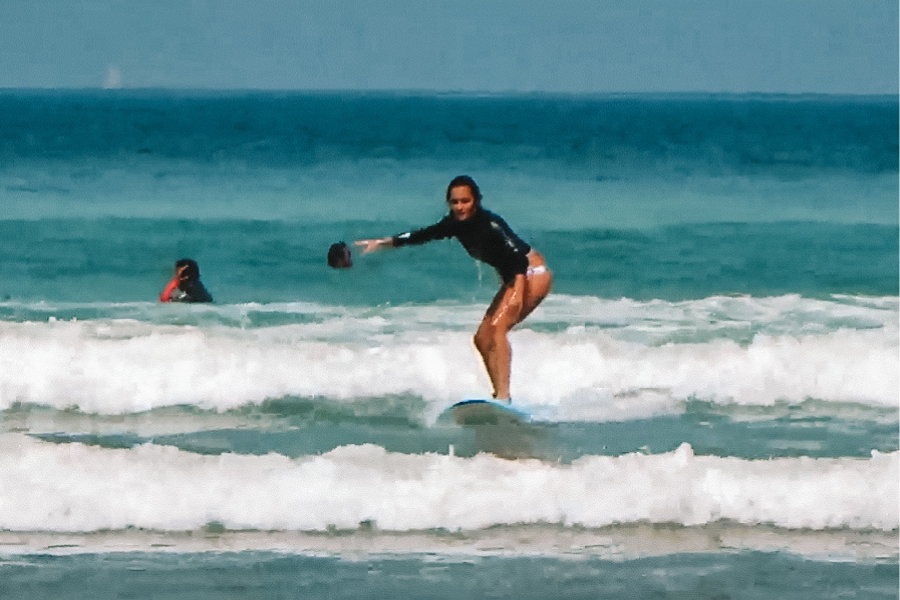
Potential Hazards:
- Currents: Be mindful of strong currents during larger swell conditions.
- Other Surfers: “Gado-Gado” is one of Bali’s top beginner surf spots, making it very crowded with surf schools and solo surfers. Make sure you have enough space to practice and always protect your head!
Surf Report Seminyak:
3. Batu Balong (Canggu)
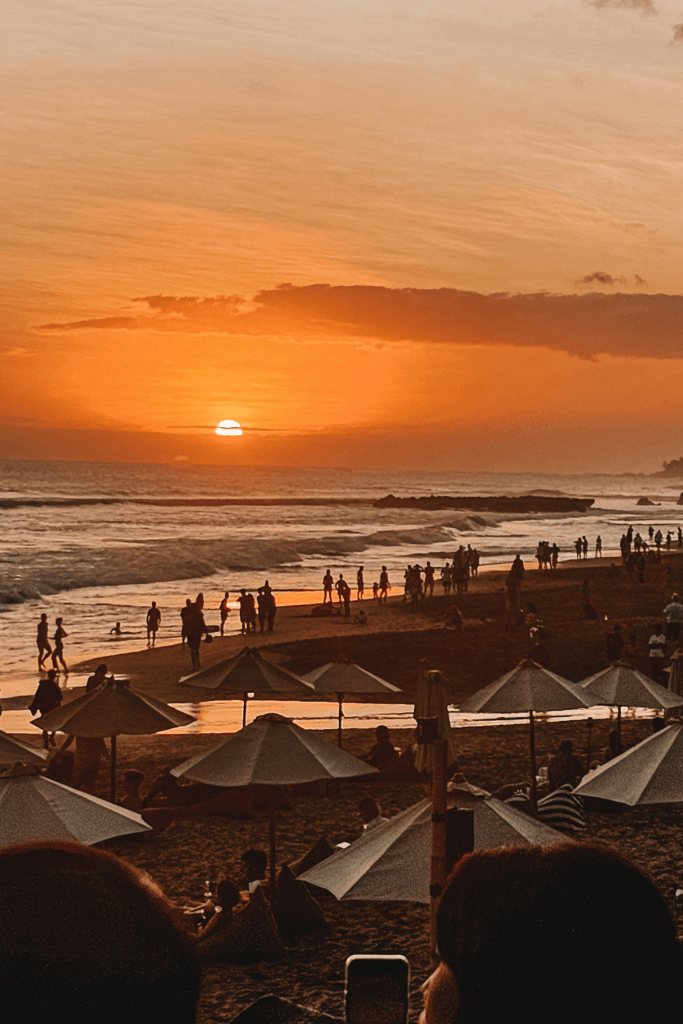
Canggu, one of Bali’s trendiest surf hotspots, definitely deserves a spot on this list. Compared to Kuta, the vibe here is more laid-back, with a focus on hip restaurants, cafés, and stylish boutiques rather than wild parties. However, the rising popularity of Canggu and its rapid growth as a hub for digital nomads, especially post-pandemic, has its downsides: overcrowded and dangerous roads, skyrocketing prices, and a loss of rice fields and traditional culture. Finding the typical Bali charm here can be challenging, but despite all this, Canggu remains a fantastic destination for surfers of all levels.
Canggu boasts three surf spots that have made it onto the list of the best surf spots in Bali: Batu Balong, Old Mans, and Berawa.
Batu Balong is a semi-beach break, meaning the bottom is partially sandy but also rocky. Technically, there’s a distinction between Batu Balong and Batu Balong Temple, though they’re only a few paddles apart. Both spots are highly popular among beginner surfers. The consistent conditions provide gently breaking, soft waves, making them ideal for those transitioning from white water to green waves. Unfortunately, the popularity also means crowded line-ups and flying beginner boards.
Tip: Try to get in the water at sunrise to avoid the busiest times. While the spot is often crowded, the atmosphere in the water is usually relaxed.
Potential Hazards:
- Shore Break: Especially at high tide, the strong shore break can be challenging. Enter the water during mid or low tide for safer conditions. (Learn everything about tides here).
- Reef: At low tide, pay attention to the rocks on the shore. Inspect the spot beforehand to identify and avoid hazards. Mid tide is the best time to surf here.
- Other Surfers: With so many beginners, it can get chaotic—always hold onto your board and stay mindful of yourself and others.
Surf Report Batu Balong:
4. Old Mans (Canggu)
Directly to the right of Batu Balong lies Old Mans, a reef break particularly favored by longboarders. The wave is slow, mellow, and easy to read—perfect for beginners with a bigger board. The deeper lineup ensures the reef is usually not an issue.
However, when the swell gets bigger, Old Mans can quickly become challenging, especially for surf newbies. While the right-hand break often closes out, the left-hand wave can even barrel! On those days, it’s worth grabbing a coconut and enjoying the view of surfers taking on the challenge
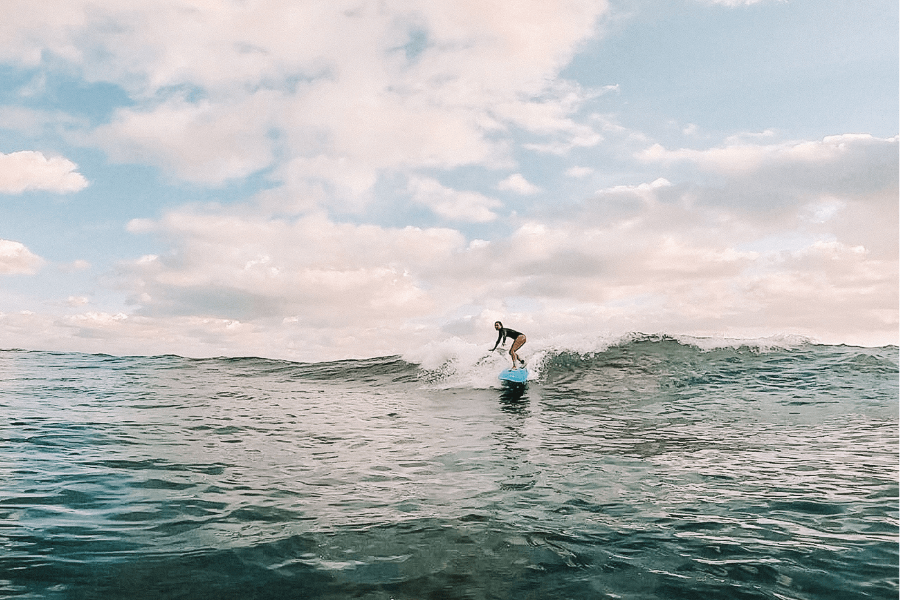
Potential Hazards:
- Other Surfers: Like Batu Balong, Old Mans is very popular and always busy. The same rules apply: hold onto your board and be mindful of yourself and others.
- Reef: While the reef is deep in the water, it can still pose a risk if you fall near the shore. Always aim to land flat, like a pancake or starfish, to minimize injury.
Surf Report Old Mans:
5. Berawa Beach (Canggu)
If you walk about 2 km south from Batu Balong Beach, you’ll reach Berawa Beach after a pleasant stroll. By car or scooter, it takes about 20 minutes as you’ll need to go around. Berawa has gained fame thanks to the renowned FINS Beach Club. Over the years, the heart of Canggu has expanded toward Berawa, with numerous restaurants and shops popping up. Today, Berawa is just as lively and pricey as central Canggu.
The semi-beach break at Berawa isn’t as consistent as Batu Balong or Kuta, but it’s often less crowded. Beginners can enjoy good white-water waves here for practicing. The best conditions are typically at mid to low tide. If you’re ready to tackle green waves, you’ll find slightly faster-breaking waves here compared to Batu Balong, making it a great spot to level up your skills.
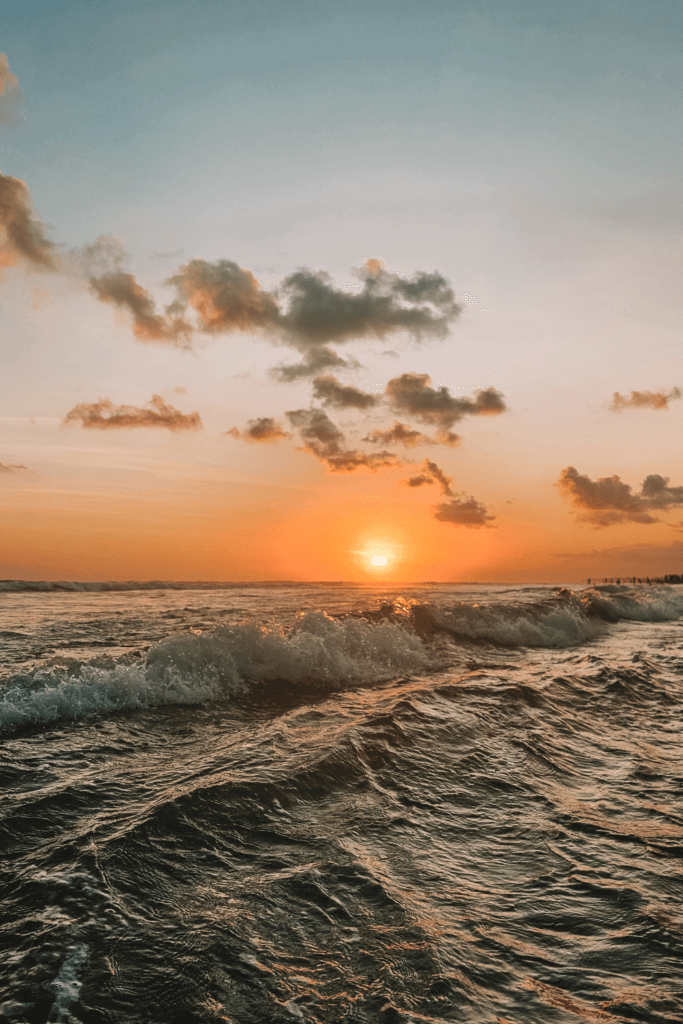
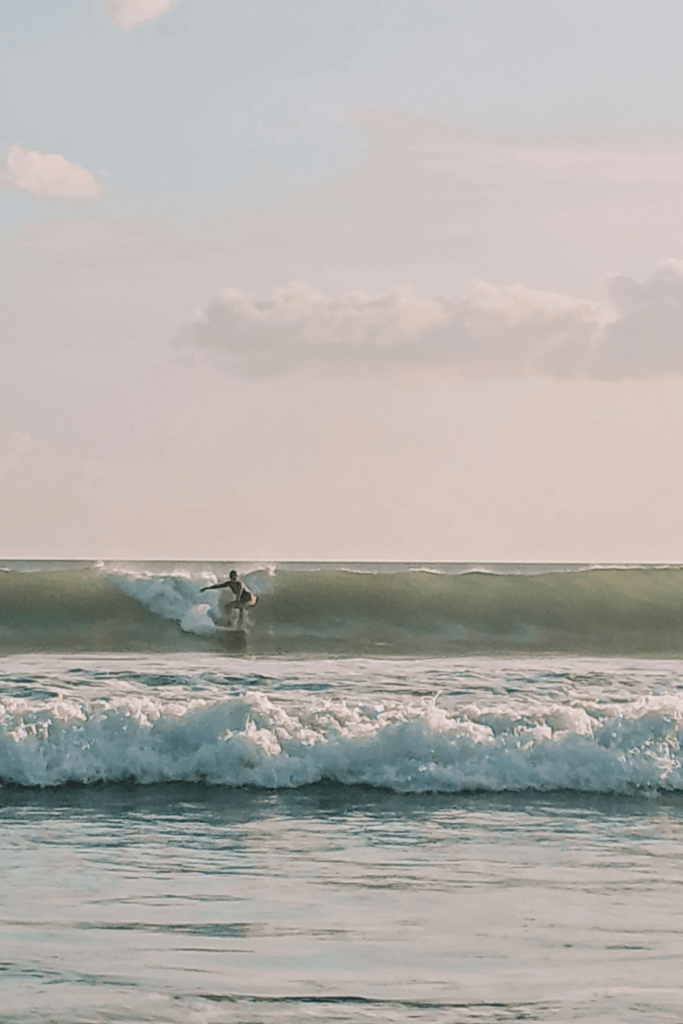
Potential Hazards:
- Currents: Strong currents can occur at this spot. For beginners, it’s best to avoid Berawa during larger swells.
- Reef: While there’s a lot of sand, particularly farther north near the FINS Beach Club, there are some larger rocks. Stick to the southern area of the spot, where you’ll also find the surfboard rentals
Surf Report Berawa Beach:
6. Baby Padang-Padang (Uluwatu)
Bad news first: Uluwatu, located in Bali’s southwest on the Bukit Peninsula, is famous for its challenging waves and rocky seabed. This surf region is not beginner-friendly at all. The surf spots in Uluwatu are among the best in the world for advanced surfers, often featuring strong currents and demanding conditions.
Good news: There’s one exception—Baby Padang-Padang, a reef break right next to Bali’s world-famous “Padang Padang” surf spot, known for its legendary left-hand barrels. Padang Padang often hosts surf competitions like the Rip Curl Cup. But Baby Padang-Padang offers ideal conditions for beginners when the swell direction and size are right.
The spot features a wide channel (to the left of the breaking wave when looking out from the beach) that allows for easy paddling into the lineup if you’re ready to try green waves. Stay near the channel to gradually adapt to the conditions. The waves here have more power compared to Batu Balong and so head out during mid-tide or higher to avoid contact with the rocks.
Baby Padang-Padang is undoubtedly one of Bali’s best surf spots for beginners with some prior experience. For absolute beginners, I recommend starting at one of the earlier mentioned (semi-) beach breaks.
To access the beach, you’ll pay a small environmental fee of 15,000 IDR (about 90 cents). The path leads down a narrow staircase through stunning rock formations, passing curious monkeys along the way. The beach itself is in a gorgeous cove with steep cliffs. The visit is worth it for the scenery alone—especially at sunset!
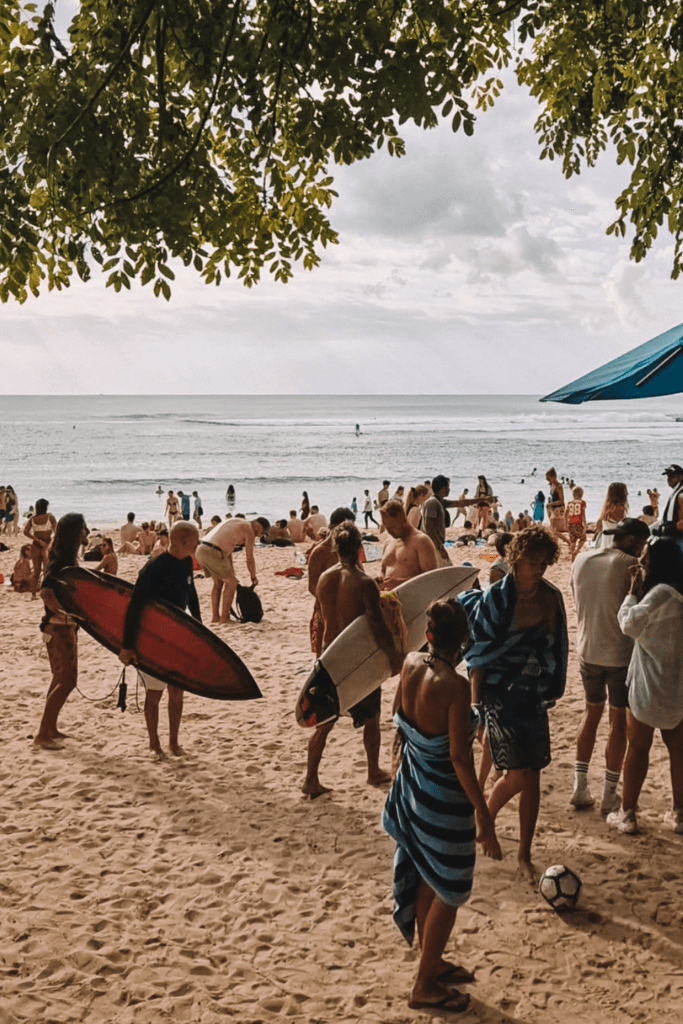
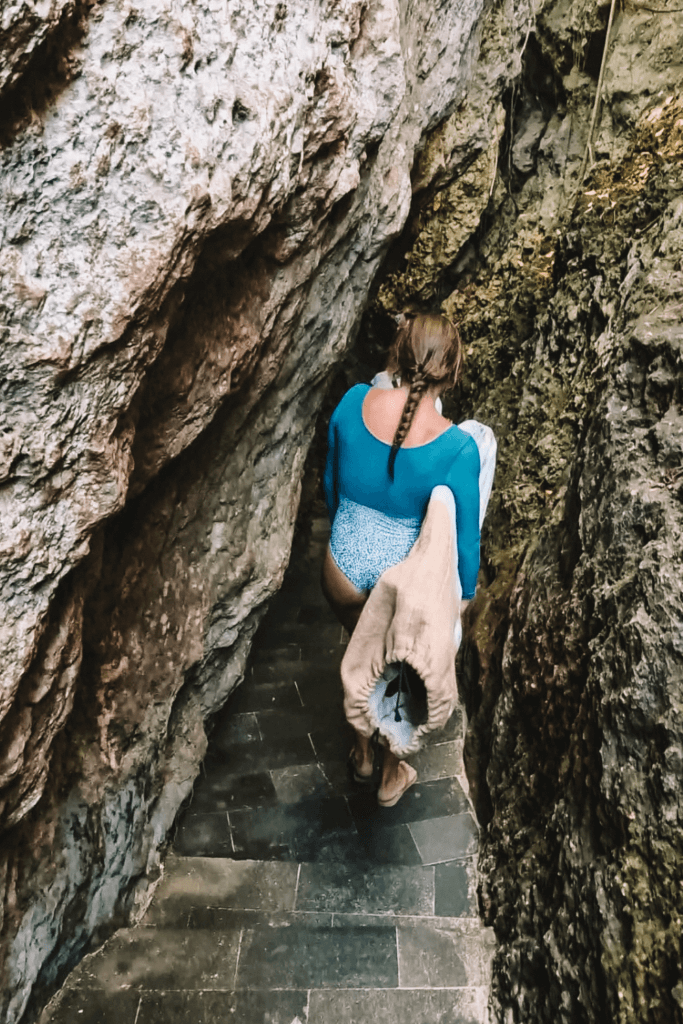
Potential Hazards:
- Currents: The stronger the swell, the stronger the currents pulling you into the breaking zone. Always stay near the channel and pick a fixed point onshore for orientation.
- Other Surfers: Baby Padang-Padang is often crowded as it’s the only true beginner spot in Uluwatu, attracting many surf schools. Stick to surf etiquette to avoid conflicts, and if you fall, paddle quickly to the channel to give others space.
- Reef: Baby Padang-Padang is a reef break, so always fall flat into the water and only surf during mid-tide or higher.
- Monkeys: The local monkeys are notorious for grabbing valuables or food—keep everything secure and avoid getting bitten.
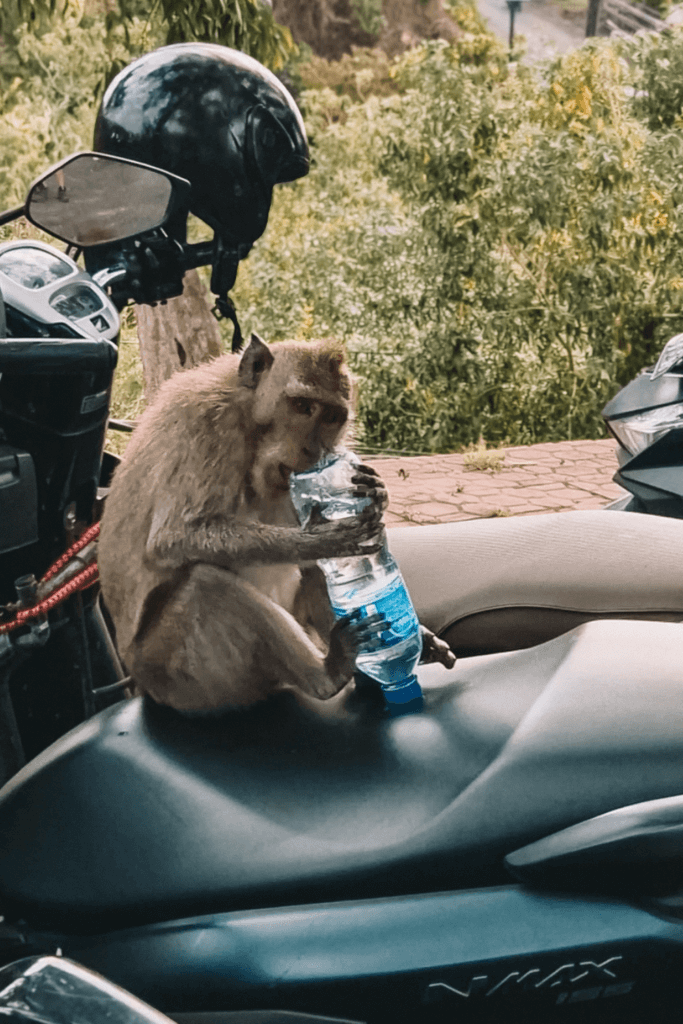
Surf Report Padang-Padang:
(there is no surf report available for Baby Padang-Padang, but Surfline shows a spot cam of Baby Padang-Padang)
7. Kedungu
Some excellent surf spots in Bali are hidden away from the tourist hotspots. Kedungu is a small, charming village about 15 minutes north of Canggu by scooter. Here, you can escape the hustle and bustle and experience a more authentic side of Bali. The famous “Tanah Lot” temple is nearby and particularly worth visiting at low tide, as this is the only time you can access all areas without wading through water.
The surf beach, with its black volcanic sand, invites you to enjoy a peaceful beach day away from the crowds. There’s a small kiosk offering snacks, local meals, and coconuts. Right next to it, you’ll find a surfboard rental and guides offering surf lessons.
The waves at Kedungu are beginner-friendly under the right conditions, especially when the swell isn’t too large. The waves break slowly and are mellow, with multiple peaks. The main peak is an A-frame with a left and right wave, located directly opposite the parking lot. The peak to the left, near the cliffs, is more challenging and has stronger currents, so beginners should avoid it. However, the second section near the cliffs is very popular with the local surf school—a small wave perfect for beginners. Early mornings are pleasantly quiet here, giving you plenty of space in the water—a real relief compared to hotspots like Batu Balong.
That said, Kedungu isn’t a spot where absolute beginners should go out alone. Sometimes there are really few people there, so if something happens, you might not get help fast enough. If you’re not with a surf school, ask at the surfboard rental for a guide to explain the specifics of the spot. Investing in a surf lesson is worthwhile and will make you feel much more confident the next time you surf.
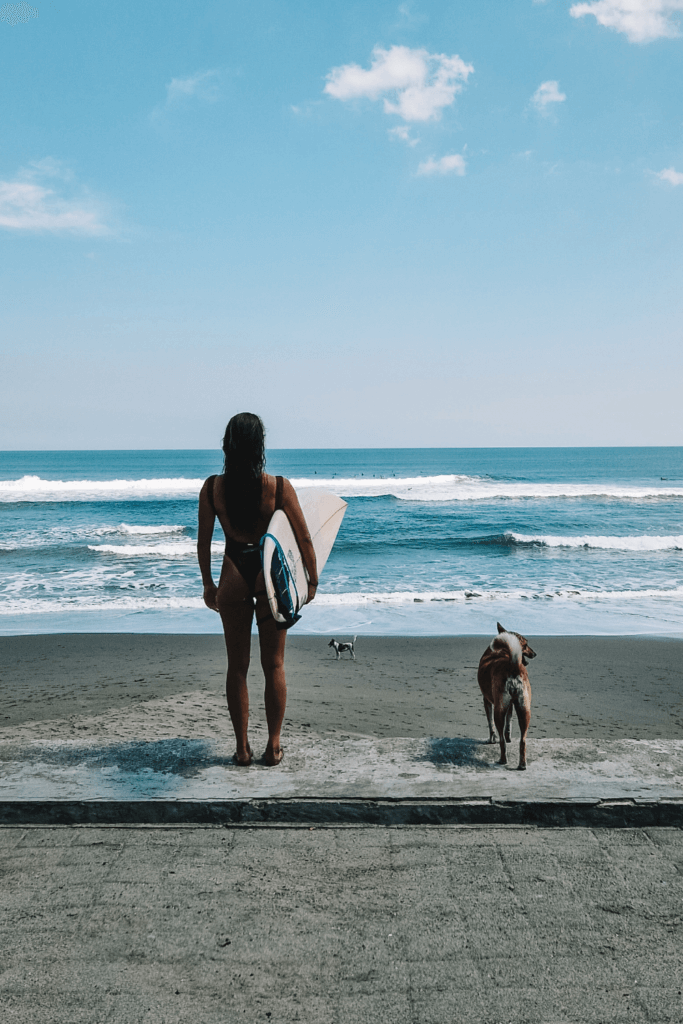
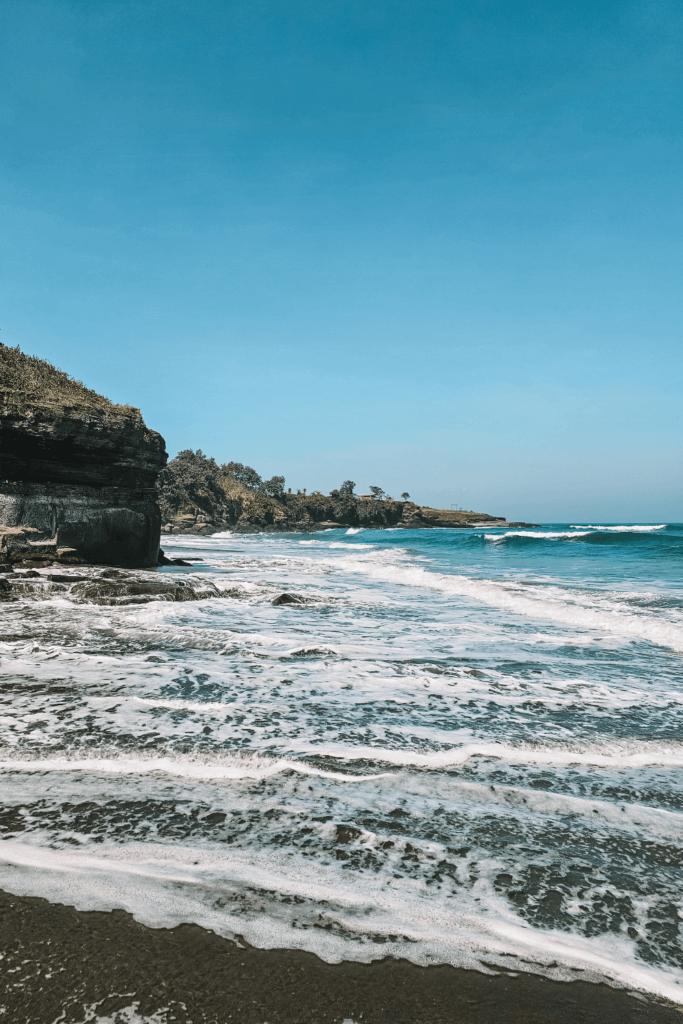
Potential Hazards
- Shore Break: Make sure to go into the water around mid-tide, as the shore break can be quite rough at high tide. (Learn more about how waves form in this article.)
- Reef: At low tide, the rocks are too close, so it’s not recommended for beginners.
- Currents: The current can be strong, especially in the outer lineup.
Surf Report Kedungu:
8. Medewi
This surf spot is located about 2.5 to 3 hours north of Canggu in a rural and tranquil area, far away from the tourist crowds. Local restaurants ensure you’re well-fed during your visit.
Medewi is not suitable for absolute beginners, as the reef break has a rocky seabed. However, once you’ve reached the intermediate level, this spot offers ideal conditions. The wave breaks gently, long, and consistently—perfect for working on your balance and practicing your first turns. Enter the water from mid-tide to high tide, and be cautious when conditions exceed 1 meter, as the spot can become quite advanced.
Due to the distance, it’s worth planning a day trip or even a short stay in Medewi. Check the surf conditions beforehand to ensure the journey is worthwhile. If the conditions are right, you’ll be rewarded with excellent waves and a significantly less crowded lineup, allowing for a stress-free surf session.

Potential Hazards:
- Reef: The seabed is rocky, so avoid surfing at low tide and always land flat, like a pancake or starfish.
- Currents: Be cautious of strong currents, especially when the conditions are larger.
Surf-Forecast Medewi:
Why You Should Book a Surf Camp!
I mention this repeatedly in my blog because it’s truly important: As a beginner, especially a first-timer, I strongly recommend starting with a surf school or surf camp and exploring surf spots with experienced guides! This is crucial for your safety, as surfing is undoubtedly a dangerous sport. Beyond the power of the water, other surfers pose a significant risk—getting hit on the head with a surfboard can be fatal. Good surf guides will choose a surf spot suitable for your skill level and find a safe practice area for you. This way, you can focus entirely on learning to surf while receiving essential knowledge stress-free.
Bali offers numerous surf schools and surf camps for all ages and budgets—with noticeable differences in quality. In a follow-up article, I’ll share my favorites.
(Just getting started on the waves? Check out my article “5 Surfing Tips for Beginners.”)
Getting There
Traveling to Bali is generally straightforward, no matter where you’re coming from. Fly to Ngurah Rai International Airport in Denpasar. From there, it’s only about 4 km to Kuta and around 19 km to Canggu or Uluwatu in the other direction. With good traffic, you can reach most popular surf hotspots within an hour.
If you want to avoid stress and hassle, consider using a shuttle service provided by your surf camp or hotel. Once you leave the airport, you’ll likely be approached by numerous Grab and Gojek drivers (local Uber-like services for scooters or cars), vying for your attention and often engaging in hectic price negotiations. A shuttle service eliminates this; your driver will be waiting at the exit with a sign bearing your name!
If a shuttle isn’t an option, here are some alternatives:
- Private Providers:
Many companies offer airport transfers. You can book these in advance or arrange them directly at the airport. - Grab & Gojek
One of the most affordable options is booking a driver via the Grab-App. Install the app before you arrive and order your ride directly through the platform. You’ll receive a fixed price, avoid tourist traps, and skip unnecessary price negotiations. Simply inform the waiting drivers that you’ve already booked, and they’ll usually leave you alone.
Tip:
As soon as I arrive at the airport, I get instant mobile internet access with an eSIM, making my onward journey hassle-free! My personal favorite is Saily – their data packages are fairly priced, and the app is super easy to use.
If Wi-Fi is enough for you, I highly recommend using a VPN like NordVPN. When connecting to public networks at airports, hotels, or cafés, your data – especially passwords – is often vulnerable to hackers. After a personal incident with Booking.com in Vietnam, I’ve become extra cautious in these situations.
Travel Tip:
Bali is especially popular during the dry season—and for good reason! The weather is mostly pleasant, travel is convenient, and there’s always a surf region with great conditions. However, high demand comes with its downsides: the island is incredibly crowded during this time, the best surf camps fill up quickly, and accommodations and restaurants are more expensive.

Why not try the off-season during the rainy season? Alongside the rain showers, you’ll still get sunny days, and the conditions are consistent—sometimes even smaller, making them better for beginners. If rain doesn’t bother you, you’ll enjoy great surf at the mentioned Bali spots while saving money and avoiding the crowds!
Summary
Bali is the perfect place to learn how to surf! Its consistent waves, excellent infrastructure, and international vibe make it an easily accessible destination. Whether you choose the dry or rainy season, Bali remains a surfer’s paradise and is always worth a visit for surfers of all levels. There’s a wide selection of beginner-friendly surf spots and plenty of opportunities to gradually tackle more challenging conditions.
It’s essential to consider the surf conditions and your own skill level, and to follow the rules in the lineup to ensure a safe and enjoyable experience. With the right planning, a suitable spot, and ideally a surf guide by your side, you’re guaranteed to have an incredible time.
While the cultural charm of Bali might feel diminished in places like Canggu or Kuta, you can still experience authentic Balinese culture by venturing a bit further afield!
This post shared my personal selection of the best surf spots in Bali for beginners and intermediate surfers.

